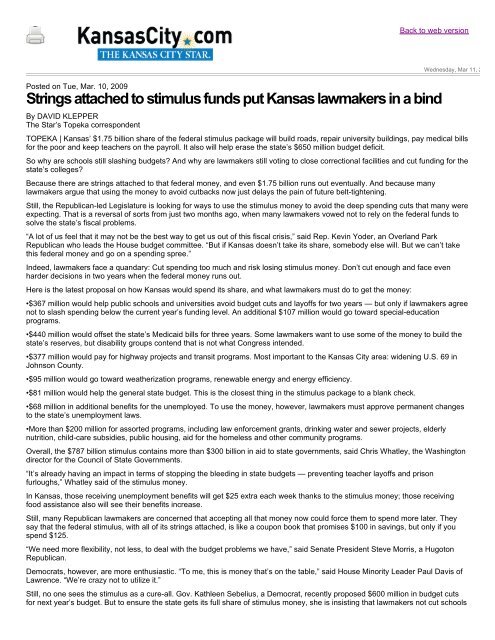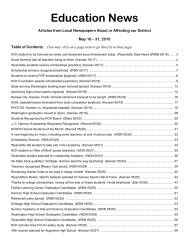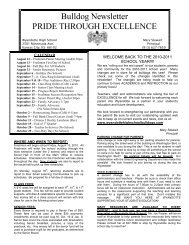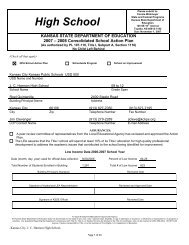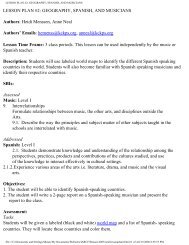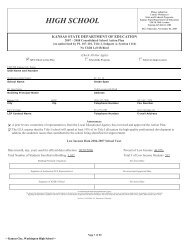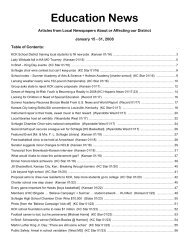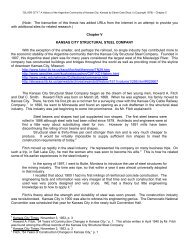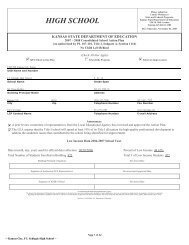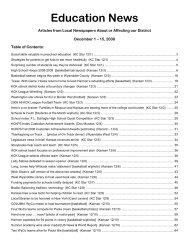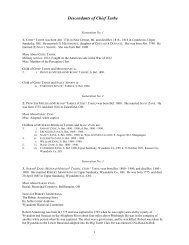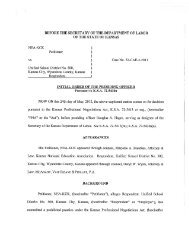March 1 - Kansas City, Kansas Public Schools
March 1 - Kansas City, Kansas Public Schools
March 1 - Kansas City, Kansas Public Schools
- No tags were found...
Create successful ePaper yourself
Turn your PDF publications into a flip-book with our unique Google optimized e-Paper software.
Back to web versionPosted on Tue, Mar. 10, 2009Strings attached to stimulus funds put <strong>Kansas</strong> lawmakers in a bindWednesday, Mar 11, 2By DAVID KLEPPERThe Star’s Topeka correspondentTOPEKA | <strong>Kansas</strong>’ $1.75 billion share of the federal stimulus package will build roads, repair university buildings, pay medical billsfor the poor and keep teachers on the payroll. It also will help erase the state’s $650 million budget deficit.So why are schools still slashing budgets? And why are lawmakers still voting to close correctional facilities and cut funding for thestate’s colleges?Because there are strings attached to that federal money, and even $1.75 billion runs out eventually. And because manylawmakers argue that using the money to avoid cutbacks now just delays the pain of future belt-tightening.Still, the Republican-led Legislature is looking for ways to use the stimulus money to avoid the deep spending cuts that many wereexpecting. That is a reversal of sorts from just two months ago, when many lawmakers vowed not to rely on the federal funds tosolve the state’s fiscal problems.“A lot of us feel that it may not be the best way to get us out of this fiscal crisis,” said Rep. Kevin Yoder, an Overland ParkRepublican who leads the House budget committee. “But if <strong>Kansas</strong> doesn’t take its share, somebody else will. But we can’t takethis federal money and go on a spending spree.”Indeed, lawmakers face a quandary: Cut spending too much and risk losing stimulus money. Don’t cut enough and face evenharder decisions in two years when the federal money runs out.Here is the latest proposal on how <strong>Kansas</strong> would spend its share, and what lawmakers must do to get the money:•$367 million would help public schools and universities avoid budget cuts and layoffs for two years — but only if lawmakers agreenot to slash spending below the current year’s funding level. An additional $107 million would go toward special-educationprograms.•$440 million would offset the state’s Medicaid bills for three years. Some lawmakers want to use some of the money to build thestate’s reserves, but disability groups contend that is not what Congress intended.•$377 million would pay for highway projects and transit programs. Most important to the <strong>Kansas</strong> <strong>City</strong> area: widening U.S. 69 inJohnson County.•$95 million would go toward weatherization programs, renewable energy and energy efficiency.•$81 million would help the general state budget. This is the closest thing in the stimulus package to a blank check.•$68 million in additional benefits for the unemployed. To use the money, however, lawmakers must approve permanent changesto the state’s unemployment laws.•More than $200 million for assorted programs, including law enforcement grants, drinking water and sewer projects, elderlynutrition, child-care subsidies, public housing, aid for the homeless and other community programs.Overall, the $787 billion stimulus contains more than $300 billion in aid to state governments, said Chris Whatley, the Washingtondirector for the Council of State Governments.“It’s already having an impact in terms of stopping the bleeding in state budgets — preventing teacher layoffs and prisonfurloughs,” Whatley said of the stimulus money.In <strong>Kansas</strong>, those receiving unemployment benefits will get $25 extra each week thanks to the stimulus money; those receivingfood assistance also will see their benefits increase.Still, many Republican lawmakers are concerned that accepting all that money now could force them to spend more later. Theysay that the federal stimulus, with all of its strings attached, is like a coupon book that promises $100 in savings, but only if youspend $125.“We need more flexibility, not less, to deal with the budget problems we have,” said Senate President Steve Morris, a HugotonRepublican.Democrats, however, are more enthusiastic. “To me, this is money that’s on the table,” said House Minority Leader Paul Davis ofLawrence. “We’re crazy not to utilize it.”Still, no one sees the stimulus as a cure-all. Gov. Kathleen Sebelius, a Democrat, recently proposed $600 million in budget cutsfor next year’s budget. But to ensure the state gets its full share of stimulus money, she is insisting that lawmakers not cut schools


